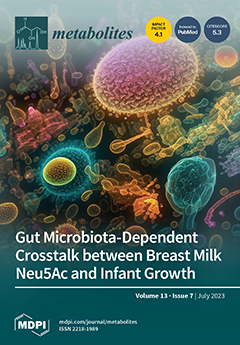Caloric restriction and aerobic and resistance exercise are safe and effective lifestyle interventions for achieving weight loss in the obese older population (>65 years) and may improve physical function and quality of life. However, individual responses are heterogeneous. Our goal was to explore the use of untargeted metabolomics to identify metabolic phenotypes associated with achieving weight loss after a multi-component weight loss intervention. Forty-two older adults with obesity (body mass index, BMI, ≥30 kg/m
2) participated in a six-month telehealth-based weight loss intervention. Each received weekly dietitian visits and twice-weekly physical therapist-led group strength training classes with a prescription for aerobic exercise. We categorized responders’ weight loss using a 5% loss of initial body weight as a cutoff. Baseline serum samples were analyzed to determine the variable importance to the projection (VIP) of signals that differentiated the responder status of metabolic profiles. Pathway enrichment analysis was conducted in Metaboanalyst. Baseline data did not differ significantly. Weight loss was 7.2 ± 2.5 kg for the 22 responders, and 2.0 ± 2.0 kg for the 20 non-responders. Mummichog pathway enrichment analysis revealed that perturbations were most significant for caffeine and caffeine-related metabolism (
p = 0.00028). Caffeine and related metabolites, which were all increased in responders, included 1,3,7-trimethylxanthine (VIP = 2.0,
p = 0.033, fold change (FC) = 1.9), theophylline (VIP = 2.0,
p = 0.024, FC = 1.8), paraxanthine (VIP = 2.0,
p = 0.028, FC = 1.8), 1-methylxanthine (VIP = 1.9,
p = 0.023, FC = 2.2), 5-acetylamino-6-amino-3-methyluracil (VIP = 2.2,
p = 0.025, FC = 2.2), 1,3-dimethyl uric acid (VIP = 2.1,
p = 0.023, FC = 2.3), and 1,7-dimethyl uric acid (VIP = 2.0,
p = 0.035, FC = 2.2). Increased levels of phytochemicals and microbiome-related metabolites were also found in responders compared to non-responders. In this pilot weight loss intervention, older adults with obesity and evidence of significant enrichment for caffeine metabolism were more likely to achieve ≥5% weight loss. Further studies are needed to examine these associations in prospective cohorts and larger randomized trials.
Full article






